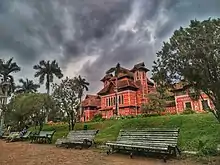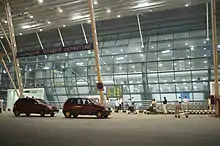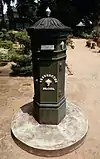History of Thiruvananthapuram
The history of Thiruvananthapuram dates back to the 10th century AD. The city and several other places in the district occupy an important place in ancient tradition,[1] folklores and literature of the State of Kerala.[2]
In 1795, the city became capital of the princely state of Travancore. Several historic landmarks of the city, including the Kowdiar Palace, University of Kerala, and Napier Museum were built during this period.
After independence, Thiruvananthapuram was made the capital of the state of Kerala.
Ancient history
According to legend, the site of Thiruvananthapuram was once a jungle known as Anantan Kādu, which was home to a Pulayar couple who cultivated rice. One day, the wife heard a baby crying as she was weeding. After a search, she found a child so beautiful that she assumed it was divine and was afraid to touch it. She fed the baby some milk and left it in the shade of a tree, whereupon a five headed cobra appeared, moved the baby to a hole in the tree and used its hood to shelter the child from the sun. Realizing it was an incarnation of the Hindu deity Vishnu, the Pulayar and his wife made offerings of milk and congee in a coconut shell. Once the king of Travancore heard of the baby, he issued orders for the construction of a temple at the location as Padmanabha swami temple.
The Ays were the leading political power till the beginning of the 10th century AD. During the Chera-Chola Wars from 999 to 1110 AD, the city of significance was Vizhinjam, which housed a university (Kanthalur Salai). Trivandrum housed the famous temple. All of the regions were attacked and sacked by the Chola army, till they were forced to retreat to Kottar in 1110 AD. The disappearance of the Ays synchronised with the emergence of the rulers of Venad.[3] During the Venad rule, the trustees of the temple (Ettarayogam) became powerful enough to challenge the authority of the rulers. Raja Aditya Varma was poisoned by them, and five out of six children of Umayamma Rani were murdered by them. In 1684, during her regency, the English East India Company obtained a sandy piece of land at Anchuthengu (Anjengo) on the sea coast, about 32 km north of Thiruvananthapuram city, for erecting a factory and fortifying it. The place had earlier been frequented by the Dutch and later by the British East India Company. It was from here that the English gradually extended their domain to other parts of Thiruvithamcore, anglicised as Travancore.
During the regency of Umayamma Rani, Travancore was invaded by a Mughal adventurer, known as the Mughal Sirdar, forcing the Rani to take refuge in Nedumangad. The Sardar camped in the suburbs of the present day Trivandrum, till he was defeated by Kerala Varma, a prince from the Kottayam royal family, adopted into the Venad royal family. The Rani was brought back in triumph to Trivandrum, but in 1696 AD, Kottayam Kerala Varma was assassinated by the trustees within the precincts of his own palace.
During the reign of another Aditya Varma (1718–1721), the clashes between the royal officials and the temple trustees became more common. Failing to get redress at the hands of the king, the tenants of the temple lands marched to Trivandrum to present their grievances to the Yogakkar (trustees), indicating the low ebb of the power of the king.
Modern history
Maharaja Marthanda Varma who reigned from 1729 to 1758, and who is regarded as the father of modern Travancore, modernised Thiruvananthapuram. The locals of Thiruvananthapuram supported him against the Ettuveetil Pillamar and Ettara Yogam when he was the heir-apparent, and when he was attacked by the agents of the trustees, he fled to the safety of Trivandrum, from where he counterattacked . During his reign, he renovated the Padmanabhaswamy Temple and the walls of the fortress. He also shifted the capital legally from Padmanabhapuram to Thiruvananthapuram, which he made a great centre of intellectual and artistic activity. In 1791, the English East India Company signed a treaty to protect Travancore from the Kingdom of Mysore and under its terms was allowed to install a Resident and troops in Thiruvananthapuram. In 1799, Velu Thampi Dalawa, then a Karyakar of Talakkulam, led a march of the local people to Thiruvananthapuram to protest against the corruption of the Kings's ministers. The accession of Maharaja Swathi Thirunal who reigned from 1829 to 1847, ushered in an epoch of cultural progress and economic prosperity. The beginning of English education was marked in 1834 by the opening of an English school at Thiruvananthapuram. An observatory and a charity hospital were also established in 1836. During the reign of Maharaja Uthram Thirunal, Rev. Mead, an Anglican priest of the London Missionary Society (L.M.S.), was employed by the Maharajah to improve the quality of education. Schools, including one for girls, were started in Thiruvananthapuram.

During the reign of Maharaja Moolam Thirunal (1885–1924), a College of Fine Arts was opened here besides the several English, Malayalam and Tamil schools, all over the State. A large hospital with lying-in-facility and a lunatic asylum were also established in Thiruvananthapuram. The Trivandrum University College was started in 1873, with Dr. Read as its principal. A Law class was opened in Thiruvananthapuram in 1874, and the main building of the old Kerala Government Secretariat was designed and constructed by the Maharajah's chief engineer, Mr. Barton. Mr. Barton also improved the sanitation of the city. It was during the reign of Sri Moolam Thirunal (1885–1924), that the Sanskrit College, Ayurveda College, Law College and a second grade College for Women were started here. A department for the preservation and publication of oriental manuscripts was also established.
One of the significant aspects associated with Maharaja Sree Moolam Thirunal's reign was the inauguration of the Legislative Council in 1888. This was the first legislative chamber, instituted in an Indian State. The Sri Moolam Assembly came into being in 1904. The activities of the Indian National Congress echoed in Thiruvananthapuram and other parts of Kerala during the reign of Maharaja Sree Moolam Thirunal.
During the regency of Maharani Setu Lakshmi Bai, the college for Women at Trivandrum was raised to the first grade.

A political conference of the Congress was held in the city under the presidency of Dr. Pattabhi Sitaramaiah, in 1938. The period of Maharaja Sri Chitra Thirunal Bala Rama Varma who took the reins of administration in 1931, witnessed many-sided progress. The promulgation of the Temple Entry Proclamation (1936) was an act that underlined social emancipation. In 1937, a separate University for Travancore was started. This was later redesignated as the University of Kerala, following the formation of the State of Kerala in 1956.
Post-Independence (1947 CE - present)
With the end of the British rule in 1947, Travancore chose to join the Indian union. The first people-elected ministry headed by Pattom Thanu Pillai was installed in office on 24 March 1948. In 1949, Thiruvananthapuram became the capital of Thiru-Kochi, the state formed by the integration of Travancore with its northern neighbour Kochi. The king of Travancore, Chitra Thirunal Bala Rama Varma, became the Rajpramukh of the Travancore-Cochin Union from 1 July 1949 until 31 October 1956. When the state of Kerala was formed on 1 November 1956, Thiruvananthapuram became its capital.
With the establishment of Thumba Equatorial Rocket Launching Station (TERLS) in 1962, Thiruvananthapuram became the cradle of India's ambitious space programme. The first Indian space rocket was developed and launched from the Vikram Sarabhai Space Centre (VSSC) in the outskirts of the city in 1963. Several establishments of the Indian Space Research Organisation (ISRO) were later established in Thiruvananthapuram.[4]
A significant milestone in the city's recent history was the establishment of Technopark—India's first IT park—in 1995.[5] Technopark has developed into the largest IT park in the geographical area,[6] employing around 40,000 people in 300 companies.[7]
References
- De Beth Hillel, David (1832) Travels (Madras publication).
- Lord, James Henry (1977). The Jews in India and the Far East; Greenwood Press Reprint; ISBN 0-8371-2615-0.
- "History of Thiruvananthapuram". Kerala PRD. Archived from the original on 7 February 2009. Retrieved 23 May 2006.
- "VSSC Thiruvananthapuram". Indian Space Research Organisation. Archived from the original on 26 April 2006. Retrieved 23 May 2006.
- "First IT Park in Kerala". Kerala State IT Mission. Archived from the original on 3 January 2021. Retrieved 25 August 2006.
- The digital challenge: information technology in the development context. S. Krishna, Shirin Madon by Ashgate Publishing, Ltd. 2003. p. 350. ISBN 9780754634454.
- "Technopark, Thiruvananthapuram". Official Site of Kerala IT. Archived from the original on 24 July 2011. Retrieved 28 October 2010.

